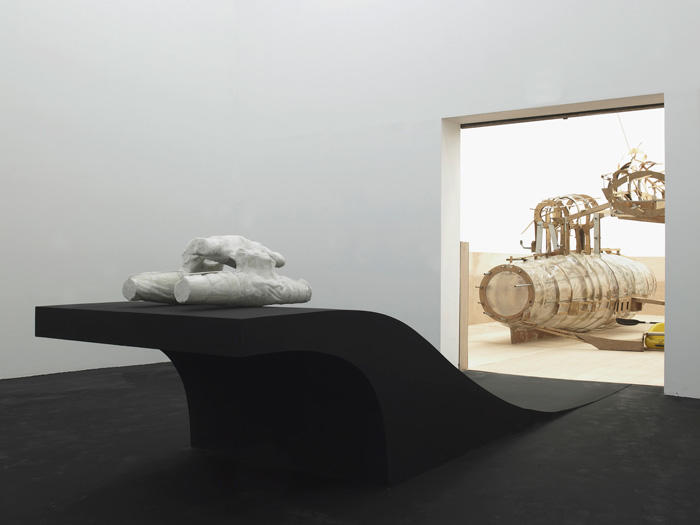Bertrand GROSOL

© Bertrand Grosol, « MAMIWATA - Pour une fiction du déplacement », 2005-2012
Vue de l'exposition « Dialogue, Bertrand Grosol et Nicolas Floc’h », Centre Régional d'Art Contemporain, Sète, 2009
Bertrand Grosol - Né en 1959 à Fort-de-France, Martinique, vit et travaille à Lyon
« Bertrand Grosol est à la fois sculpteur, réalisateur, compositeur, poète, etc., autant de catégories que sa pratique artistique remet en cause par les déplacements permanents qu'elle opère. Les différents projets en cours qu'il mène en parallèle et ré-alimente sans cesse, révèlent des histoires cachées dans les interstices du réel. L'œuvre comprenant sa propre destruction, des documents photographiques, vidéographiques, des livrets sous forme de carnet de bord, enregistrent la trace de ces circonvolutions.
ORI est un projet commencé et présenté à La Réserve à Montpellier en 2003. Une gravure au sol du schéma de l'oreille interne est progressivement enfouie sous 128 tonnes d'asphalte noir. En Martinique, son lieu de naissance, Bertrand Grosol superpose ce motif à la carte de l'île dans l'idée d'enregistrer différentes données sonores et visuelles en différents points de l'île. […]
Le MamiWata est "un projet de navigation intérieure, sur une structure flottante imaginée, qui joindrait trois mers : Mer Méditerranée – Mer du Nord – Mer noire, par les voies fluviales, les canaux. Un aller à contre-courant du sud vers le nord, un flux inversé, une expérimentation singulière". Né en 1995, d'une discussion, ce projet devient voyage-fiction et prend la voie d'une expérience solitaire à partir de 2004, avec la construction, dans les anciens entrepôts des Salins en bord de Saône, de l'embarcation MamiWata L820L650H320 : squelette tubulaire de bois et de métal recouvert d'une pellicule de résine. En 2005, en Résonance avec la 8ème Biennale de Lyon, l'embarcation est mise à l'eau à la jonction de la Saône et du Rhône. En 2007, le MamiWata L820L650H320 est exposé au Musée d'art contemporain de Lyon. La disparition programmée de l'image symbolique de la maquette marquera la fin du projet. […]
Le projet du MamiWata traduit un processus d'exploration empirique divisé en chapitres, ouverts aux allers-retours, aux digressions. L'œuvre ne cesse de se réinventer. [...] Par l'enregistrement des métamorphoses invisibles issues des dérives fluviales, le projet du MamiWata retrace l'aventure d'un voyage utopique, initiatique, aux confins des mondes flottants. » […]
Extrait du livret de l'exposition « Dialogue, Bertrand Grosol et Nicolas Floc’h », Centre Régional d'Art Contemporain, Sète, 2009
« Par son mode opératoire, mon travail s'inscrit dans la durée, et cette durée lente et constante ne permet pas de disposer de pièces d'exposition, mais plutôt d'inventer des constructions qui donnent à voir ce qui est en train de se faire. Les constructions disparaissent ou évoluent avec l'avancée du projet. » B.G.
____
Bertrand Grosol - Born in 1959 in Fort-de-France, Martinique, lives and works in Lyon, France
About the exhibition at CRAC Sète, 2009
Excerpt from the exhibition booklet Dialogue, Bertrand Grosol et Nicolas Floc’h, Centre Régional d’Art Contemporain, Sète, 2009.
Translated by Lucy Pons, 2019
Bertrand Grosol is at once a sculptor, a filmmaker, a composer, a poet, etc. – categories which his artistic praxis challenges through the permanent shifts it operates. The various projects he works on simultaneously and nurtures on a constant basis reveal stories that are hidden in the cracks of reality. Because the work itself contains its own destruction, photographic and videographic documents and journal-like notebooks record the trace of these convolutions.
ORI is a project that was initiated and presented at La Réserve in Montpellier in 2003, and which consisted in gradually burying an engraving of the inner ear under 128 tonnes of black asphalt. In Martinique, his place of birth, Bertrand Grosol overlaid the same motif with the map of the island, as if to record various acoustic and visual data in different parts of the island. […]
MamiWata is “an inner navigation project built on an imaginary floating structure designed to connect three seas – the Mediterranean, the North Sea, and the Black Sea – via inland navigation and canals. A journey against the current from South to North, an inverted flow, a singular experiment.”
The project originated in 1995 during the course of a discussion, then later became a fictional journey and a solitary experience as from 2004, with the construction, in the former salt warehouses on the banks of the Saône, of the craft MamiWata L820L650H320, a tubular wood and metal frame coated in a layer of resin. In 2005, concurrently to the 8th Lyon Biennale, the craft was set afloat at the junction of the Saône and Rhône rivers. In 2007, MamiWata L820L650H320 was shown at the Museum of Contemporary Art in Lyon. The programmed destruction of the symbolic image of the boat’s model brought the project to a close. […]
The MamiWata project exhibits a process of empirical exploration, divided into chapters and open to departures and digressions. The piece never ceases to reinvent itself. […] By recording the invisible metamorphoses of the river drifts, the MamiWata project retraces the adventure of a utopian and initiatory journey at the far reaches of floating worlds.
“Because of its protracted nature and its slow and consistent pace, my work method does not produce exhibition pieces, but rather allows me to invent constructions that expose to view what is being done at any given time. These constructions disappear or evolve as the project moves on.” B.G.
Site internet et réseaux sociaux
Documents d'artistes Auvergne-Rhône-Alpes - Partenariat Centre national des arts plastiques / Réseau documents d'artistes.